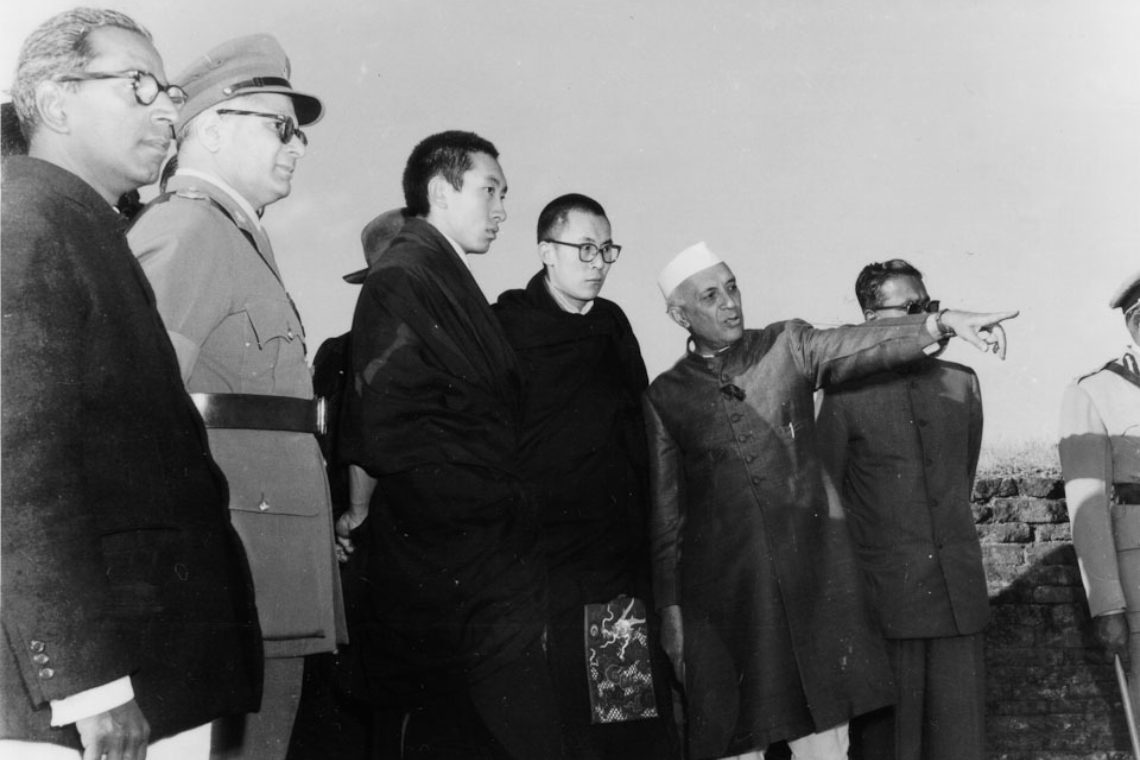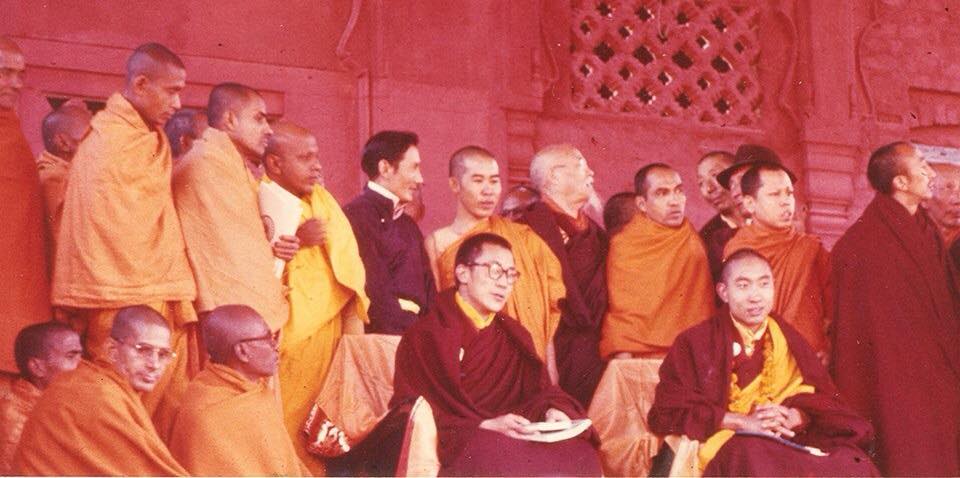Know When The Dalai Lama First Visited India? It’s Probably Not When You Think
"For us Tibetans, India is Aryabhumi, the Land of the Holy," says this 'Son of India'.

When India attained Independence on August 15, 1947, there were questions about what Free India should adopt as its national symbols. In many ways, Buddhism represented the aspirations and ethos of a New India. The Constituent Assembly had little hesitation in adopting India’s rich Buddhist heritage, and the symbols eventually chosen reflected it.
The Ashoka Chakra in the centre of the white section of the Indian flag is the Law of Dharma wheel – a Hindu and Buddhist symbol. The wheel denotes motion. The four-headed lion capital of the Buddhist Emperor Ashoka, representing the fearless proclamation of Dharma to the four quarters of the world, was adopted as the official seal of the Republic.
In line with Buddhism’s resonance on the new Republic, the Government of India decided that in 1956 it will sponsor and organise nationwide celebrations of the 2500th anniversary of the Buddha’s birth.
Taking a personal interest in arranging this special event, India’s first Prime Minister Pandit Jawaharlal Nehru felt that the country could use this occasion to project itself as a leading Asian power in the post-colonial era. Vice President Dr S Radhakrishnan was appointed the head of the organising committee. The government also chose to appoint Kushok Bakula Rinpoche, the noted Buddhist monk and Ladakhi statesman, as a member of the organising committee.
To the uninitiated, the 19th Bakula Rinpoche was both a revered Buddhist spiritual master and a statesman of immense stature from Ladakh. He was also singularly responsible for the revival of Buddhism in Mongolia during his 10-year stint as India’s ambassador to Mongolia. The airport in Leh is named after him. Read more about him here.

Soon after the organising committee held its first meeting on May 20, 1955, the Prime Minister’s Office sent a communique to Rinpoche. In it, the Government of India asked Rinpoche to coordinate with the then Government of Tibet (despite massive Chinse incursions into the region, Tibet still had its own government) based in Lhasa for the participation of HH the 14th Dalai Lama and the 10th Panchen Lama in the Buddha Jayanti celebrations, scheduled for the following year.
Rinpoche was asked to lead the Indian delegation to Tibet, where he would personally meet with Tibetan officials. On December 29, 1955, Rinpoche arrived in Lhasa, where he stayed for a couple of days at the residence of PN Menon, India’s then Consul General. There, he was apprised of the growing Chinese presence in the region, and other confidential matters.
In an interesting aside, on January 26, 1955, Rinpoche had the honour of unfurling the Indian national flag in the Consul General of India premises at Deki Ling during Republic Day celebrations. Four days later, on January 30, 1956, Rinpoche had a private audience with the Dalai Lama at the famed Potala Palace in Lhasa. During the meeting, Rinpoche informed him about the purpose of his visit and spoke at length about other matters. By then, the GoI had already extended official invitations to the Dalai Lama and Panchen Lama.
In May 1956, Buddha Jayanthi celebrations commenced in India and lasted the entire year. On May 24, 1956, India’s first President, Dr Rajendra Prasad announced that the ridge area of Delhi, a large and green-belt area in the capital, was henceforth to be known as the Buddha Jayanti Park. Besides, facilities for Buddhist pilgrims to visit holy sites like Sarnath, Bodh Gaya, Kushinagar and others, were set up in time for the celebrations.
In November, the Dalai Lama, who was only 21-years-old at the time, arrived at Palam Airport in New Delhi with a large entourage of Tibetan dignitaries.

At the airport, he was extended a welcome fit for a Head of State. The Indian government presented him with a guard of honour. Prime Minister Nehru and Vice President Radhakrishnan personally received him at the airport. While the Dalai Lama resided at Hyderabad House. Assigned with the task of accompanying both the Dalai Lama and Panchen Lama, Rinpoche travelled with them.
Little did the Dalai Lama know that three years later he would undertake a miraculous escape into India after the Chinese army occupied Tibet.
The religious significance of this visit was not lost on anyone. However, there was another element to it. “This visit by the 14th Dalai Lama provided an opportunity to undertake direct diplomatic exchanges with Government of India in particular, Jawaharlal Nehru, concerning the unfolding occupation of the Kham and Amdo regions of Tibet by the Chinese army (PLA).
Departing Lhasa at the end of November with a small entourage that included the Panchen Lama and his older brother, Lobsang Samten, they travelled to Gangtok in Sikkim and later to New Delhi, alongside the Maharaj Kumar of Sikkim, Palden Thondup Namgyal, who was then president of the Maha Bodhi Society,” writes historian David Geary in his book titled “The Rebirth of Bodh Gaya: Buddhism and the Making of a World Heritage Site,” where he examines the modern revival of Buddhism in India.
Along with a massive entourage of devotees from Tibet, the Dalai Lama also performed his first major “public religious act” on Indian soil by going on a pilgrimage to some of the holiest Buddhist sites, where he offered teachings, including one in Bodh Gaya on December 27.
“On this special occasion, thousands of people thronged the seven-mile route from Gaya to Bodh Gaya as the entourage drove through numerous welcome arches that had been erected in honour of their visit. Upon reaching the temple, with an international reception of Buddhist monks and visitors, the Dalai Lama and Panchen Lama presented sets of Tibetan Buddhist Scriptures to the temple management committee along with a gold lamp to be used in daily worship,” writes David Geary.
Even the Dalai Lama couldn’t contain his excitement about his visit to India. In his famous autobiography titled “Freedom in Exile,” he makes a special note of his thoughts before this visit.
“I was ecstatic. For us Tibetans, India is Aryabhumi, the Land of the Holy. All my life I had longed to make a pilgrimage there: it was the place that I most wanted to visit,” he wrote. “I finally left Lhasa full of joy at the prospect of being able to move about freely without the constant supervision of some Chinese official or other.”

This visit to Bodh Gaya, although the first, wouldn’t be his last. The significance of this visit was not lost on the Dalai Lama. He was acutely aware of how powerfully his visit to the land where Buddhism was born would resonate in India, Tibet, and of course, China. “These earlier instances of pilgrimage marked the beginning of a new ritual relationship with the Buddhist holy land and its increasing deterritorialized Tibetan community,” adds Geary.
“[While travelling in India] I reflected on how different India felt from China. I had been there for no time at all, but already I was aware of an immense gulf between the way of life of the two countries. Somehow, India seemed so much more open and at ease with herself,” the Dalai Lama writes.

The Dalai Lama often refers to himself as a “Son of India”, and his writings reflect how that sentiment began to permeate his mind even before his escape to India in 1959. “I was able to give myself wholly to deep feelings of joy and veneration as I journeyed across the country from Sanchi to Ajanta, then to Bodh Gaya and Sarnath. I felt that I had returned to my spiritual home,” he writes of his 1956 visit to India.
It’s been nearly 60 years since the Dalai Lama escaped from China, and it’s safe to say that India has been honoured to host this most venerable spiritual leader, despite recent developments.
Like this story? Or have something to share? Write to us: [email protected], or connect with us on Facebook and Twitter.
NEW: Click here to get positive news on WhatsApp!
If you found our stories insightful, informative, or even just enjoyable, we invite you to consider making a voluntary payment to support the work we do at The Better India. Your contribution helps us continue producing quality content that educates, inspires, and drives positive change.
Choose one of the payment options below for your contribution-
By paying for the stories you value, you directly contribute to sustaining our efforts focused on making a difference in the world. Together, let’s ensure that impactful stories continue to be told and shared, enriching lives and communities alike.
Thank you for your support. Here are some frequently asked questions you might find helpful to know why you are contributing?


This story made me
-
97
-
121
-
89
-
167













